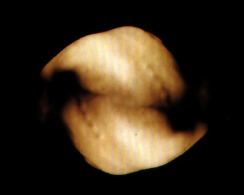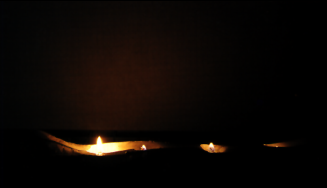Infinit (dos)
AN EXPERIENCE OF CONFLICT
As the universe - both as a terminological question and as an allegorical concept, the idea of the body has been erected in one of the broadest and most profound metaphorical figures that have emerged in the lands of Western culture For centuries, perhaps, because no, for a mere matter of anthropometric proximity or also of existential centrality. In recent years, in addition, and already immersed in the specific field of plastic arts, the image of the body has worked in many different ways, and not always physical, or even -and in spite of redundancy-, not always corporeal The image of the body traditionally and progressively contemplated from its many different meanings - political, social, economic, religious, sexual, reproductive, hierarchical - has been increasingly associated with an image of the body as a support for theoretical discourse, as a figurative image, as a sexual symptom, as a mental liberation, as a sense of production, as a transmitter of diseases, or as a simple - at the same time that terrible - prolific scene of pain and pleasure, which also arise and They command sweat, semen and blood, a scenario, full of metaphorical references, allegorical allusions and a whole corpus that goes far beyond what is their strict three-dimensional presence.
The history of the body as the construction of one's own history, that is, as an indexed collection of one's own experience -with which it is imbued in a necessarily indestructible way- is one of the main nuclei of the work of Sebastià Oliva i Marc Palau, a nucleus that is, in addition, and perhaps in a not very common way, an example that is sufficiently revealing how the work of the artist can sometimes run parallel to the same process of learning or discovery of certain values and elements carried out by the person, causing discourse and existence to come together in perspectives, we would almost say that natural, even for mere issues of age and of trajectory or experience. Whatever the case, however, is the idea of finding that in the field of visual arts we can also discover examples of something more or less equivalent to what would literally be said in Bildungsroman, it seems to us now to be really interesting The work that the two artists present to today is mainly the momentary fruit of a research process that began approximately last year and that is still in evolution and construction, both in terms of its formalization and the elaboration of the thought: it is not, then, properly, of a work but of a stage - yes, increasingly complex and elaborate - of a segment of artistic discourse that is still waiting to complicate -it's more and take other three-dimensional and, above all, more corporal aspects, never more so. Infinit (two) already shows some of the future elaborations, both conceptual and formal, that the work of artists must incorporate in the next formalizations:
A progressive appropriation of object-oriented references - metaphorically - the logical extension to the lands of the installation and the necessary inclusion of small actions or other works completely identified with the world of body art - so that they allow The viewer is a more appropriate read of the entire cluster of images of bodies and transformations that the projections offer as a result or as a realization of three-dimensional experiences previously carried out. Infinite (two) is, before anything else - and this seems quite obvious - a proposal to reflect on the status of the body as a physical entity and at the same time as a cultural notion - and, therefore, social, historical, sexual -, which causes all the elements that emerge to act as a kind of index or general summary of questions that interest the artists most, and some of which, perhaps, are presented as only annotated , like waiting for other moments to develop more properly. But we should also point out that, beyond the more direct references to the body, a deep idea of time and a reflection on the temporary agent as a constructive factor of the specific artistic discourse is also present at the core of his work: in this Factor falls, for example, to a large part of the final responsibility of a work that is installed fundamentally in the structure of the process devices as a transforming element of the ideas and conceptions of the art work.
In its most generic aspects, Infinit (two) develops a theme already discussed in a previous installation -exhibited in Reus-, and in which two characters are shown as a party to the progressive evolution and transformation of their most recognizable attributes, in such a way that not only does a fusion or confusion of some of the foundational aspects of the idea of body occur, but, among other things, there is a confusion between the simple perceptual limits and everything that defines each one of the two characters, that is, a dissolution of aspects already related more directly to identity, which is a kind of ironic look at the low solidity of identities as we have understood so far and a metaphorical look at the Logic need to understand them in a much broader and more generous ways. The two characters presented to the work have all the cluster of habitual localizers - social, sexual, sexual, cultural, historical, and sanitary - as human bodies: the progressive transformation that they undergo brings them to processes that they make change their own recognition as such social bodies, in order to force them to find a kind of ultimate essence that, although reduced, allows to encompass all the previous differentiations and abolish any significant separation. The construction of the staging of the work presents other peripheral aspects that also intervene in the construction of the notion of body as well as of its subversion, and they settle in a powerful contemporaneity of the reflection of the artists, constructing a series of allegorical images that place us at the time we live and at the crucial moment in which this reflection occurs: the idea of struggle, destruction, death, interaction, construction, l experience, the processes of existence, the duels, the roles.
A last idea about the concepts of transformation and conflict: as a good part of the art that has worked the idea of body in these last three decades as a support, as an agent, as a substitute, as a metaphor, as a fragment, as a flock-, the processual elements that reveal the aspects of transformation are of particular importance in the work that Marc Palau and Sebastià Oliva show us, because they work with an element that is lived and in which the idea of transformation necessarily corresponds to the idea of growth and learning and, in some sense, to the one of death and decadence, all of which is located in the social space, which by itself is sufficiently connotant. Pleasure and pain or identity and depersonalization are not the only dual elements of the conflict but I know they are an indissoluble, constructive part: along with them, artists let the same body screen show its repertoire of elements without which this idea does not It would be complete, some elements that refer to the capital situation of the idea of body, body-concept as an experiment of social behavior, as a subject of identity speculation, as a term in which fluids provide more questions connotative, as an art demonstration screen, as a sublimation of the individual, and as a confirmation that the change in the perception of the body and in the body's own experience establishes a discourse that is increasing and progressing, Spiral-shaped structure, enlarging and enlarging to cover more and more elements, more conflicting and more transformative, more intense and more capable, in short, of constituting terr Global experience of this powerful experience.




